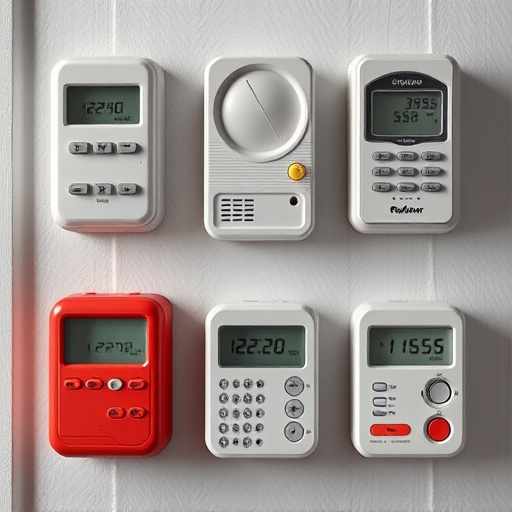Personal protection keychains offer immediate safety with loud sounds and attention-drawing capabilities. The primary difference between rechargeable and battery-operated models is their power sources: rechargeables are eco-friendly and cost-effective, while batteries provide instant access and longer durations, often with strobe lights for dark scenarios. Rechargeables never run out of power, ensuring constant protection, whereas battery models require regular replacement. Each caters to distinct preferences and personal safety needs, with rechargeable keychains becoming popular due to their convenience and sustainability compared to traditional battery-powered alarms. When choosing, consider the balance between long-term savings (rechargeable) and instant protection (battery-powered).
Personal protection is a top priority, especially when venturing alone. One compact yet powerful tool gaining traction is the discreet personal protection keychain alarm. This handy device offers a simple and effective way to deter potential threats with just a quick press of a button. In this article, we’ll explore the intricacies of these alarms, focusing on their design, power sources, and how to select one that best suits your needs, highlighting the key differences between rechargeable vs battery-powered models.
- Understanding Personal Protection Keychain Alarms
- Discreet Design: A Key Feature
- Rechargeable vs Battery-Powered Alarms: Pros and Cons
- Choosing the Right Discreet Personal Alarm for You
Understanding Personal Protection Keychain Alarms
Personal protection keychain alarms are compact, portable devices designed for immediate personal safety. These small yet powerful tools emit a loud sound to deter potential attackers, drawing attention and alerting others nearby. Understanding the different types is key to choosing the right defense option. One significant distinction lies in power sources: rechargeable vs battery-operated personal alarms. Rechargeable models are eco-friendly and cost-effective as they can be replenished over time, whereas battery-powered options provide instant ready access with regular replacement needs.
Battery-driven alarms often feature longer loudness durations and additional features like strobe lights for enhanced visibility in dark scenarios. Conversely, rechargeable alarms may have shorter sound duration but the advantage of never running out of power, ensuring constant protection. Each type has its merits, catering to various preferences and requirements for personal safety.
Discreet Design: A Key Feature
The discreet design of personal protection keychains is a key feature that sets them apart from traditional alarm devices. These compact and unassuming gadgets are crafted to blend seamlessly into your daily carry, often resembling everyday keys or accessories. This subtle approach ensures users can stay safe without drawing unwanted attention, making it an ideal choice for those seeking peace of mind in crowded spaces or high-risk areas.
Unlike typical battery-powered alarms that may require frequent replacements, many modern keychains opt for rechargeable models, offering a more sustainable and cost-effective solution. This is particularly advantageous when considering the long lifespan of such devices, ensuring users stay protected without constant worry about depleting batteries. The shift towards rechargeable options in personal alarms, especially those designed to fit on keys, underscores the evolving need for convenient, eco-friendly safety measures.
Rechargeable vs Battery-Powered Alarms: Pros and Cons
When choosing between rechargeable and battery-powered personal alarms, understanding their unique advantages and drawbacks is key. Rechargeable options offer a more eco-friendly and cost-effective solution in the long run. They eliminate the need for frequent battery replacements, reducing waste and saving you money. Once fully charged, these devices can provide extended usage, making them ideal for everyday carry or travel. However, the initial investment for rechargeable alarms might be higher, and they may require more time to recharge compared to disposable batteries.
On the other hand, battery-powered alarms are readily available and often come at a lower upfront cost. They ensure instant protection without any waiting for charging times. Yet, you’ll need to replace batteries regularly, which can add up over time, making them less environmentally friendly. These alarms might also have shorter duration between charges, requiring more frequent replenishment during extended use scenarios.
Choosing the Right Discreet Personal Alarm for You
When selecting a discreet personal protection keychain alarm, understanding the difference between rechargeable and battery-powered options is key. Rechargeable models offer a more sustainable choice as they eliminate the need for frequent battery replacements, proving to be both cost-effective and environmentally friendly. These devices can be conveniently recharged via USB, ensuring you’re always prepared without the hassle of carrying extra batteries.
On the other hand, battery-powered alarms provide instant protection with no charging required. While they may require regular battery changes, these devices are generally more affordable upfront. Consider your lifestyle and needs: if you’re often on the go and need quick, reliable protection, a battery-operated alarm might be the better choice. Yet, if sustainability and long-term cost savings are priorities, opt for a rechargeable model.
When it comes to personal safety, choosing the right discreet keychain alarm is a smart move. Whether you opt for a rechargeable or battery-powered model, these compact devices offer peace of mind and can be easily carried on your keys. Understanding the differences between rechargeables and battery alarms, their pros and cons, will help you make an informed decision to enhance your personal protection.
